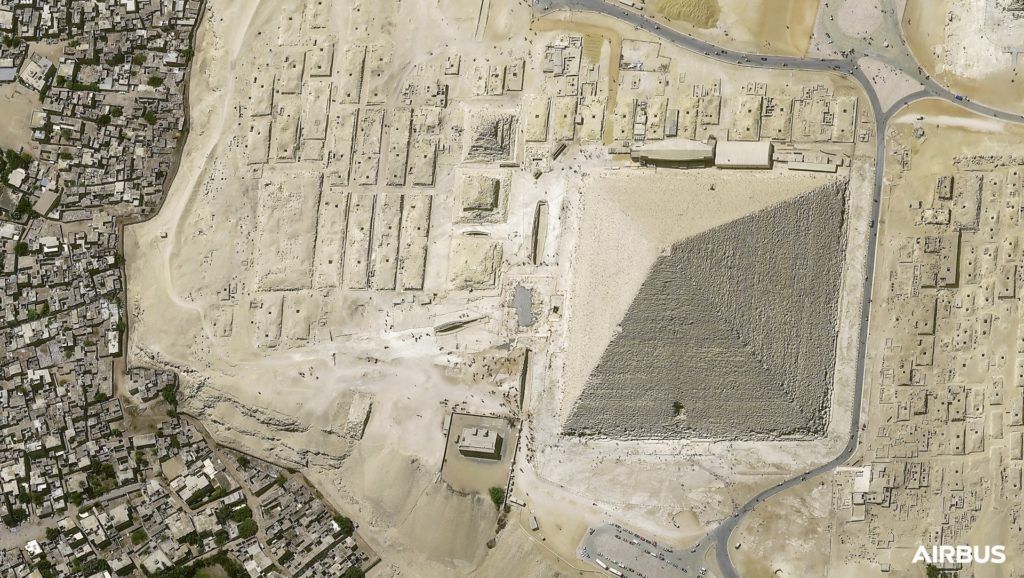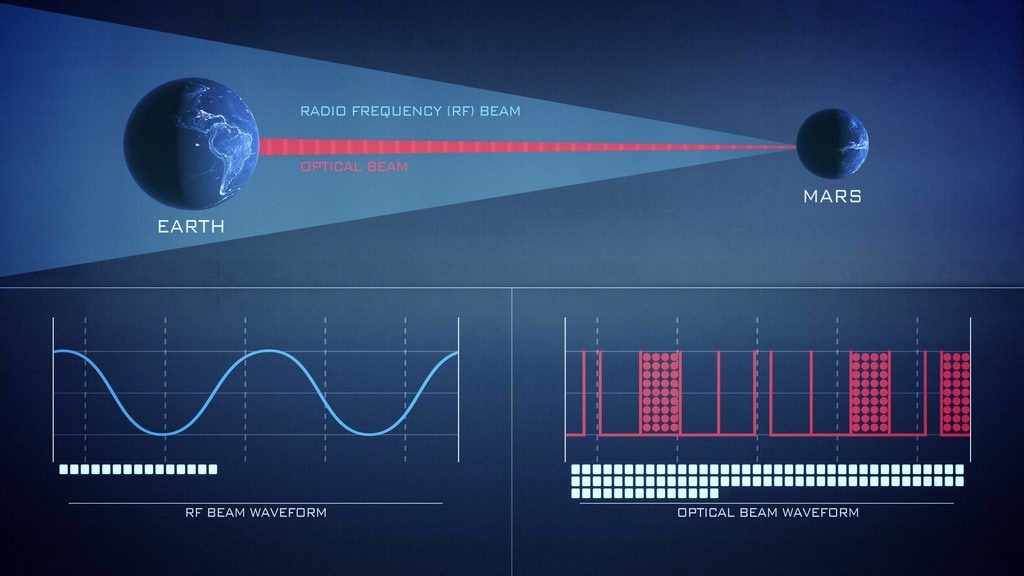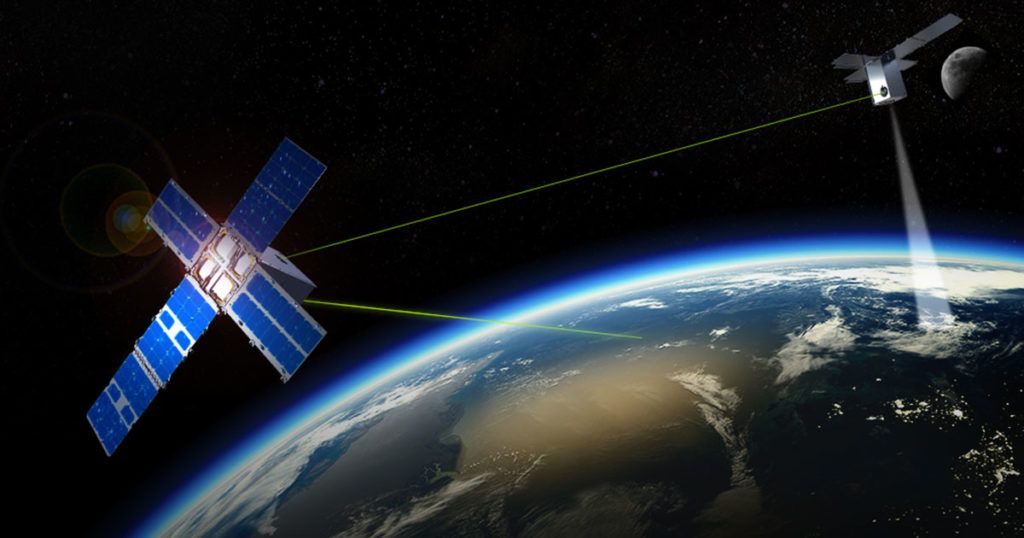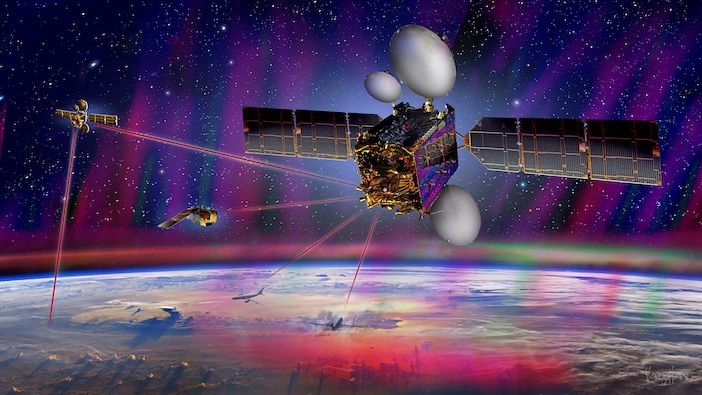The use of laser-based satellite communications for the high-speed transmission of large amounts of data is being tested by engineers in space, providing the next step for the internet in terms of speed, bandwidth and applications.
Airbus launched the UltraAir project in May. The two-year research project is developing and flight testing a prototype terminal for use onboard aircraft to enable the receiving and transmitting of data using lasers beamed to and from satellites.
Meanwhile NASA plans to launch its Laser Communications Relay Demonstration (LCRD) satellite this year, which it says could transmit data at rates of up to 1.2Gbps.
UltraAir
Airbus’ UltraAir will use the SpaceDataHighway (SDH), Airbus’ laser-based communications service which it provides using its European Data Relay Satellites (EDRS). SDH was launched in 2016 and currently consists of two satellites.

Laurent Grouès, head of the SDH at Airbus Defence and Space said, “We can offer bandwidth at an unprecedented rate using laser communications – up to 1.8Gbps – and it will only get faster and better. It has a lot of benefits.
“The data rate is much higher using laser communications. Importantly it overcomes RF’s limitations, where there is only limited spectrum availability. Laser-based communications provide resilience, protection and security.
“Our ambition with the UltraAir is to bring this technology from space, where it has already proven to be incredibly reliable, down to Earth for new applications such as airborne connectivity.”
The UltraAir test program, which is being run with the European Space Agency and Dutch research agency TNO will have three main steps: laboratory testing, then testing from a ground station in Tenerife, Spain to connect to a spacecraft. Finally a prototype UltraAir terminal will be flight tested by creating a data link from inside a Falcon 20LX.
Mathias Wiegand , head of EDRS implementation at Airbus Defense and Space said, “While the UltraAir uses entirely new technologies, we are trying to leverage available technology as much as possible.
“Pointing at the satellite 40,000km away is the biggest technical challenge, with all the vibrations from the aircraft.”
Technology from UltraAir could be used to both improve connectivity on commercial airliners and to improve communications and management of air, land and naval vehicles across battlefields.
The LCRD, which uses technology similar to the SDH, will link to ground stations in California and Hawaii and then next year be used as a communications relay for the International Space Station.
European Data Relay Satellites
The EDRS satellites that provide the infrastructure for the SDH service were launched in 2016 and 2019. It is the first commercially-available laser satellite service in the world. Around 2000 terabytes (2 petabytes) have been transferred over 50,000 links.
EDRS uses ground stations in Europe. The existing customers for the EDRS satellites are the European Commission and ESA with Copernicus and their 4 Sentinel 1 and 2 LEO Earth observation satellites
The SDH will soon serve a further the four Pléiades Neo constellation of Earth-imaging satellites, the first of which was launched in April, will also use the SDH. The first highly detailed images from the Pléiades Neo satellite were received in May.

(Image: Airbus)
As well as relaying data to Earth, laser communications will provide inter-satellite links to distribute data between small satellites in mega constellations. “We will see a massive increase of satellites equipped with laser terminals,” says Grouès.
As the demand for data increases, new relay satellites will have to be launched. “We would like to have new nodes in geostationary orbit so we can offer a fully global network,” says Grouès.
Commercial and civil applications
A combination of UltraAir and SDH opens up the possibility of many applications in the defense and commercial space. However Laurent says that is unlikely commercial services offering laser-based communications for airlines will be available before the end of this decade.
UltraAir, or a version of it, will more likely be seen in the defense sector first. “The main advantage is that it brings the capability to communicate in places where you can’t normally communicate,” Grouès says. “In this type of application, a main node above the clouds would aggregate and distribute data from and to all other nodes and link to the satellite.”
This means better communication and management of battlefields across air, land and sea domains where communications infrastructure to facilitate it doesn’t exsit. “The second application is ISAR, directly linking drones and providing real time surveillance.”
USA laser-based satellite communications programs
Europe has a lead in laser communications technology and is the first to offer a commercial service, but governments and companies across the world are working hard to develop the technology and close that lead.
NASA’s Laser Communications Relay Demonstration (LCRD), which uses technology similar to the SDH, will link to ground stations in California and Hawaii and then next year be used as a communications relay for the International Space Station.
The satellite for the LCRD was expected to be launched in June, but technical problems with the rocket carrying it has delayed the project to later in the year.
According to NASA, the LCRD will demonstrate technology capable of increasing bandwidth up to 100 times more than radio frequency systems.

The LCRD system consists of microwave-oven-size optical modules that will send and receive data over infrared lasers from geosynchronous orbit 22,000 miles above Earth.
LCRD experiments will allow engineers to refine the transmission process, study different operational scenarios, and refine tracking systems. The LCRD program will also generate essential data and information to prepare laser communications systems for operational missions where engineers cannot replicate the same conditions with ground tests.
LCRD will also provide laser communications relay services with a terminal on the International Space Station next year. These operations could prove the viability of using laser communications in future crewed missions to the Moon and Mars.
“LCRD will demonstrate all of the advantages of using laser systems and allow us to learn how to use them best operationally,” said Principal Investigator David Israel at NASA’s Goddard Space Flight Center in Greenbelt, Maryland. “With this capability further proven, we can start to implement laser communications on more missions, making it a standardized way to send and receive data.”
LINCS launch
In addition to NASA, US aerospace and defence contractor General Atomics is testing its Laser Interconnect and Networking Communication System (LINCS) satellite this summer in partnership with the USA’s Space Development Agency (SDA).
LINCS, which is being launched on a SpaceX Falcon 9 comprises of two 12U cubesats each hosting a C-band dual-wavelength full duplex optical communication yerminal (OCT) and an infrared payload.
An OCT integrated onboard an airborne GA-ASI MQ-9 “Reaper” drone flying at around 25,000ft will communicate with the cubesats in low earth orbit as part of the program.

LINCS has been designed and built by GA-Electro Magnetic Systems (GA-EMS) to test the capabilities of laser-based communication in space and to increase its speed, distance, and variability.
“The launch of our two cubesats, supporting the LINCS mission, demonstrates GA-EMS’ ability to provide a complete tailored solution of both satellites and payloads integrated into an affordable design that provides customers significant launch versatility and cost effective solutions to their missions,” said Nick Bucci, vice president of Missile Defense and Space Systems at GA-EMS.
“GA-EMS has invested significantly in enabling technologies, including adaptive optics that compensate for such distortions, to allow our OCTs to provide two-way, low latency, high-bandwidth, secure communication to warfighters in whatever domain they operate.”
Technical and regulatory challenges
With several different programs in development, the opportunities seem large. However, there are barriers to adoption. Grouès says, “We will see mainstream applications using laser-based communications once there is technical consistency and accepted standards.”
There is also one main technical barrier when considering applications for laser communications technology on the Earth’s surface – atmospheric conditions. When the weather is cloudy links to the geostationary satellites is not possible. Site diversity utilizing multiple uplink terminals at different geographical positions overcomes this limitation.
“Optical communication to an air, ground, or maritime asset proposes a different set of challenges than space-to-space communication, because you have to account for distortions to the optical beam caused by atmospheric elements like weather, clouds, dust, and even wind,” said Bucci.
“Laser communications won’t replace radio communications, but it will add extra bandwidth and new capabilities across all markets, to existing and new solutions,” says Grouès.
“This technology is a game-changer. It will result in completely new ways to connect and communicate, adding new capabilities.”





